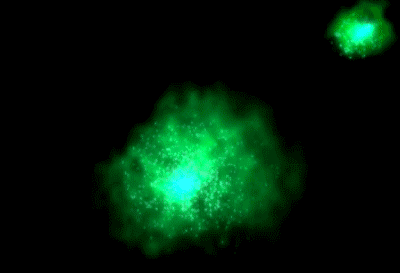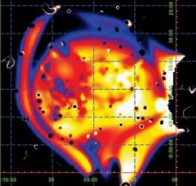Clash of the galaxies
An X-ray image unveils an immense collision between two huge clusters of galaxies
By Emily Sohn
Being in a car accident or train wreck would be scary enough. But can you imagine getting caught in a galaxy wreck?
A new image might give you an idea of what that would be like. Astronomers have taken a picture of an enormous collision between two of the universe’s most massive clusters of galaxies. The merging clusters each contain hundreds of galaxies and millions upon millions of stars. It’s the most powerful cosmic collision yet recorded in such a clear image.
 |
|
This sequence of images shows how an artist imagines a collision between two clusters of galaxies. Such a massive collision sprays galaxies in all directions, disrupting the skyscape in much the same way that a hurricane tosses aside trees and buildings t
|
| NASA |
There are just a few hundred large galaxy clusters in the universe, scientists estimate. Between 20 and 30 of them are probably crashing into each other and merging right now.
To get the new image, astronomers from the University of Honolulu in Hawaii used the European Space Agency’s orbiting XMM-Newton telescope. They pointed it at a cluster called Abell 754, which is 800 million light-years away from Earth. The cluster contains about 1,000 galaxies.
 |
|
The XMM-Newton telescope orbits Earth.
|
| European Space Agency |
The astronomers already knew that Abell 754 was in the middle of some kind of collision, but they weren’t sure of all the details. By detecting X rays produced by the cluster, they were able to pick out huge shock waves hurled into outer space by the collision.
 |
|
This image, based on X-ray data, shows the temperature of gas in and around the two colliding and merging galaxies. The galaxies themselves can’t be seen. The colored pattern represents gas heated up by shock waves created in the collision. The hottest r
|
| ESA/XMM-Newton/Patrick Henry et al. |
The X-ray patterns revealed that the second cluster involved in the collision was smaller than Abell 754 and contained about 300 galaxies. Further analysis also indicated that the smaller cluster had plowed into the bigger one.
The collision has been going on for about 300 million years, and it’s not over yet. After a few billion years more, the two clusters will be fully merged into one.
Now that’s no small fender-bender!







